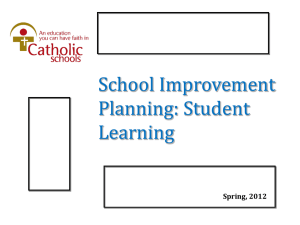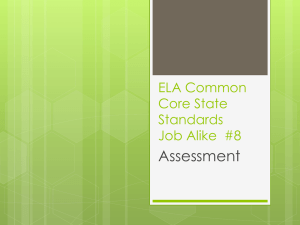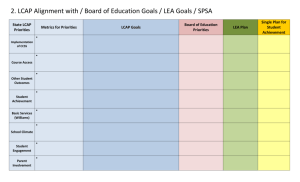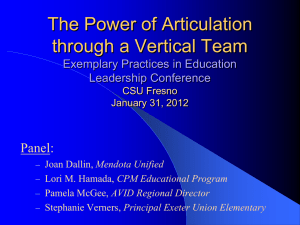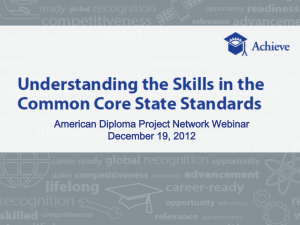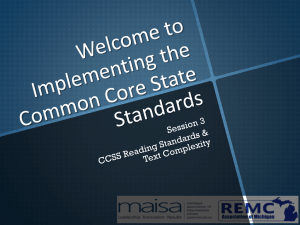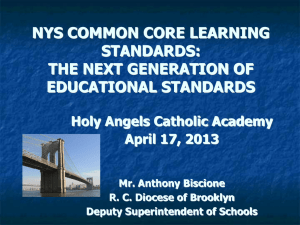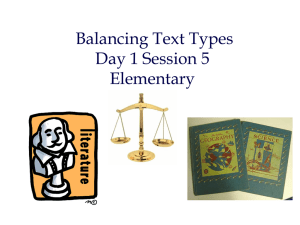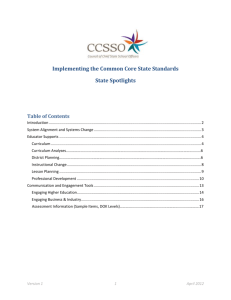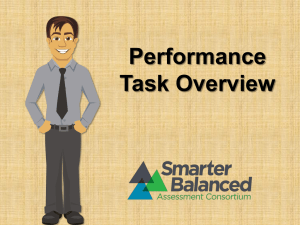CommonCore_Full_Day_Teacher_Overview
advertisement
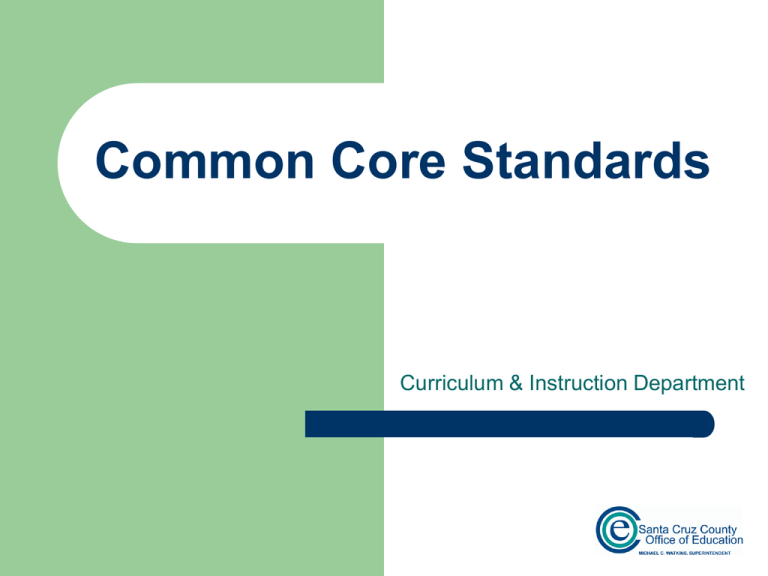
Common Core Standards Curriculum & Instruction Department Outcomes To review the history and rationale behind the Common Core State Standards. To learn about the CA Common Core State Standards for Mathematics and English Language Arts Plan for instructional adjustments based on the CA Common Core State Standards Working Agreements Given the agenda and the outcomes, what working agreements can we agree upon to help us accomplish the tasks at hand? Be… Respectful Responsible Ready “The primary aim of education is not to enable students to do well in school, but to help them do well in the lives they lead outside of school.” Source: International Center for Leadership in Education “In the long-term, education must aim for active use of knowledge and skill. Students gain knowledge and skills in schools so they can put them to work in professional roles—scientist, engineer, designer, doctor, business person, writer, artist, musician—and in lay roles— citizen, voter, parent—that require appreciation, understanding, and judgment.” David Perkins Harvard University What Do We Know? - Activity 1) 2) 3) 4) Based on your experience, stand in the corner whose number best matches your knowledge of Common Core… I’ve never heard of Common Core. I’ve heard of them but don’t know how they effect me. I know California has adopted the CCS in Math and ELA, and I have looked at them. I’ve studied the similarities and differences, and have begun to develop lessons which incorporate them. 44 States and Counting Common Core Standards Criteria Rigorous Clear and specific Teachable and learnable Measurable Coherent Grade by grade standards Internationally benchmarked Common Core State Standards • Vertically articulate downward from college and career readiness standards “ ” – Logical learning progressions – Focus on developmental appropriateness higher clearer fewer MANTRA Key Points – English Language Arts Organized around College and Career Readiness Standards Strands are headed by CCR anchor standards that are identical across all grades ELA sets requirements for reading & writing in other content areas Shared responsibility for students’ literacy development What We Know to Be True… Students of the 21st Century require that we teach them new literacy skills: “how to read purposefully, select materials that are of interest, learn from those materials, figure out the meanings of unfamiliar words, integrate new information with information previously known, resolve conflicting content in different texts, differentiate fact from opinion, and recognize the perspective of the writer – in short, they must be taught how to comprehend.” Catherine E. Snow Foreward from Reading Next A Report to the Carnegie Corporation of New York, 2004 11 Lexile Framework Semantic Difficulty Syntactic Complexity The Lexile scale is based on uniform increments from 200L to 2000L. An increment of 100L is constant in terms of increase in semantic and syntactic complexity. 12 2005-06 Lexile Framework® for Reading Study Summary of Text Lexile Measures Interquartile Ranges Shown (25% - 75%) 1600 Text Lexile Measure (L) 1400 1200 1000 800 600 High School Literature College Literature College High School Textbooks Textbooks Military Personal Entry-Level Use Occupations SAT 1, ACT, AP* 2005-06 Lexile Framework® for Reading Study Summary of HS Textbook Lexile Measures Interquartile Ranges Shown (25% - 75%) 1400 Text Lexile Measure (L) 1300 1200 1100 1000 900 800 ELA Math Science Social Studies Subject Area Textbooks Arts CTE College and Career Readiness Standards for Reading College and Career Readiness anchor strands organized in four key areas: 1. Key Ideas and Details 2. Craft and Structure 3. Integration of Knowledge and Ideas 4. Range of reading and Level of Text Complexity Design and Organization - ELA Three main sections K−5 (cross-disciplinary) 6−12 English Language Arts 6−12 Literacy in History/Social Studies, Science, and Technical Subjects Three appendices A: Research and evidence; glossary of key terms B: Reading text exemplars; sample performance tasks C: Annotated student writing samples Design and Organization - ELA Four strands Writing Reading Language Listening & Speaking Key Points An integrated model of literacy Media requirements blended throughout 18 19 20 Writing Write informative pieces, well-reasoned arguments and narrative texts Identify audience and adapt writing to purpose and task Conduct research Provide evidence Incorporate appropriate technology to create, collaborate on and refine writing Significant time and effort, numerous pieces Writing Write routinely over extended time frames (time for research, reflection, and revision) and shorter time frames (a single sitting or a day or two) for a range of discipline-specific tasks, purposes, and audiences. (2-12.W.10) Example/ Science Technical Sample Task A: Evaluating Evidence Compare what the latest science tells us about Genetically Modified food against the arguments for and against Genetically Modified food. Evaluate the hypotheses, data, analysis, conclusions of each side, and including determining the extent to which each side in the debate relied on the available science, argues from an economical perspective, or appeals to the political and emotional concerns. Verify the data and either support or challenge the conclusions with other sources of information. CCSS 11-12 RST.8 Source: Achieve Example/ Science Technical Sample B – Making a claim Read and view different examples of case-making materials related to GM food. Take a position and cite specific textual evidence from your sources, attending to important distinctions each authors makes and to any gaps or inconsistencies in the account. Defend your conclusion from counter-claims Create a presentation of your analysis that highlights key evidence and your strongest claims. CCSS 11-12 RST 1. and RST 9. Source: Achieve Speaking and Listening Communicate effectively in whole class, small group, partner situations Analyze and synthesize increasingly large amount of information Participate in rich, structured conversations Language Conventions for writing and speaking Vocabulary acquisition In context of reading, writing, speaking and listening Focus on Text Complexity By the end of the year, read and comprehend literature, including stories, dramas, and poetry, at the high end of the grades 4-5 text complexity band independently and proficiently. (5.RL.10) Initiate and participate effectively in a range of collaborative discussions (one on one, in groups, and teacher led) with diverse partners on grades 1112 topics, texts, and issues, building on others’ ideas and expressing their own clearly and persuasively. (11-12.SL.1) Vocabulary Acquisition Participate in collaborative conversations with diverse partners about grade 2 topics and texts with peers and adults in small and larger groups. (2.SL.1) Use precise language and domain-specific vocabulary to inform about or explain the topic. (7.W.2.d) Determine the meaning of word and phrase as they are used in the text, including figurative and connotative meanings; analyze the cumulative impact of specific word choices on meaning and tone (e.g., how the language evokes a sense of time and place; how it sets a formal or informal tone.) (9-10.RL.4) Critical Analysis and Use of Evidence Distinguish their own point of view from that of the narrator or those of the characters. (3.RL.6) Summarize the points a speaker or a media source makes and explain how each claim is supported by reasons and evidence, and identify and analyze any logical fallacies. (5.SL.3) Develop claim(s) and counterclaim(s) fairly and thoroughly, supplying the most relevant evidence for each while pointing out the strengths and limitations of both in a manner that anticipates the audience’s knowledge level, concerns, values, and possible biases. (11-12.W.1b) WHAT GRADE LEVEL? IS THIS LITERARY OR IS IT INFORMATIONAL TEXT? Grade 7 Informational Craft and Structure 4. Determine the meaning of words and phrases as they are used in a text, including figurative, connotative, and technical meanings; analyze the impact of a specific word choice on meaning and tone. Based on the 7th grade standard we identified, what might a performance task look like to assess proficiency? Performance Task Students determine the figurative and connotative meanings of words such as wayfaring, laconic, and taciturnity as well as of phrases such as hold his peace in John Steinbeck’s Travels with Charley: In Search of America. They analyze how Steinbeck’s specific word choices and diction impact the meaning and tone of his writing and the characterization of the individuals and places he describes. [RI.7.4] Comparing ELA Standards With an elbow partner, discuss what you notice about how the Common Core Standards and the current state standards are the same or different. CCSS Overarching Goals Ensure that our students are: – – – Meeting college and career expectations Prepared for 21st Century Literacy and success in a Global Economy Provided with rigorous and relevant content Design and Organization of Math Aim for clarity & specificity Stress conceptual understanding of key ideas Balance mathematical understanding and procedural skill Are internationally benchmarked *See Handout Standards for Mathematical Practices Mathematically Proficient Students: 1. 2. 3. 4. 5. 6. 7. 8. Make sense of problems and persevere in solving them Reason abstractly and quantitatively Construct viable arguments and critique the reasoning of others Model with mathematics Use appropriate tools strategically Attend to precision Look for and make use of structure Look for and express regularity in repeated reasoning •K-8 Mathematics •Standards define what students should understand and •be able to do. •Clusters are groups of related standards, •Domains are larger groups of related standards. Domain Standard Number and Operations in Base Ten 3.NBT Use place value understanding and properties of operations to perform multi-digit arithmetic. 1. 2. 3. Use place value understanding to round whole numbers to the nearest 10 or 100. Fluently add and subtract within 1000 using strategies and algorithms based on place value, properties of operations, and/or the relationship between addition and subtraction. Multiply one-digit whole numbers by multiples of 10 in the range 1090 (e.g. 9 x 80, 5 x 60) using strategies based on place value and properties of operations. Cluster Math Domains K - 8 California Grade 8 Options Develop Conceptual Understandings Solve addition and subtraction word problems, and add and subtract within 10, e.g., by using objects or drawings to represent the problem. (K.OA.2) Add and subtract within 100, using concrete models or drawings and strategies based on place value, properties of operations, and /or the relationship between addition and subtraction; relate the strategy to a written method. Understand that in adding or subtracting three-digit numbers, one adds or subtracts hundreds and hundreds, tens and tens, ones and ones; and sometimes it is necessary to compose or decompose tens or hundreds. (2NBT.7) HS Pathways 1.) Traditional (US) – 2 Algebra, Geometry and Data, probability and statistics included in each course 2.) International (integrated) three courses including number , algebra, geometry, probability and statistics each year 3.) Compacted version of traditional – grade 7/8 and algebra completed by end of 8th grade 4.) Compacted integrated model, allowing students to reach Calculus or other college level courses Key Advances Focus and coherence Focus on key topics at each grade level. Coherent progressions across grade levels. Balance of concepts and skills Content standards require both conceptual understanding and procedural fluency. Mathematical practices Foster reasoning and sense-making in mathematics. College and career readiness Level is ambitious but achievable. Emphasis on Mastery Fluently multiply and divide within 100, using strategies such as the relationship between multiplication and division (e.g. knowing that 8 x 5 = 40, one knows 40÷5 = 8 or properties of operations. By the end of grade 3, know from memory all products of two one-digit numbers. (3.OA.7) Fluently multiply multi-digit whole numbers using the standard algorithm. (5.NBT.5) A focus on fractions Represent a fraction 1/b on a number line diagram by defining the interval from 0 to 1 as the whole and partitioning it into b equal parts. Recognize that each part has size 1/b and that the endpoint of the part based at 0 locates the number 1/b on the number line. (3.NF.2.a) Solve word problems involving addition and subtraction of fractions referring to the same whole, including cases of unlike denominators, e.g. by using visual fraction models or equations to represent the problem. Use benchmark fractions and number sense of fractions to estimate mentally and assess the reasonableness of answers. For example, recognize an incorrect result 2/5+1/2= 3/7 by observing that 3/7<1/2 (5.NF.2) High School Mathematics The high school standards are listed in conceptual categories: – Number and Quantity – Algebra – Functions – Modeling(*) – Geometry – Statistics and Probability Modeling standards are indicated by a (*) symbol. Standards necessary to prepare for advanced courses in mathematics are indicated by a (+) symbol. High School Mathematics a) b) c) Build a function that models a relationship between two quantities. * Determine an explicit expression, a recursive process, or steps for calculation from a context. Combine standard function types using arithmetic operations. For example, build a function that models the temperature of a cooling body by adding a constant function to a decaying exponential, and relate these functions to the model. (+) Compose functions. For example, if T(y) is the temperature in the atmosphere as a function of height, and h(t) is the height of a weather balloon as a function of time, then T(h(t)) is the temperature at the location of the weather balloon as a function of time. Identify Changes… With an elbow partner, discuss any significant changes you notice in the math standards. Assessment! Summative/Formative Summative Formative End of unit, quarter and/or year Final results No grade Multiple choice, extend response, performance assessment International Center for Leadership in “Feedback” helps student to improve Part of regular classroom learning SMARTER Balance Timeline Treasure Hunt With a partner, use the CA Common Core State Standards in ELA or Math to navigate through this new document and find the answers to the questions on your hand out. Key Takeaways Activity Divide in partner teams – – One partner reads Mathematics document and the other partner will read ELA document Use the Coding Strategy (hand-out) while reading the Key Takeaway document to support your reflection on the following questions: What information did I already know? What information is new? What information do I not understand? What information is particularly interesting? Lunch “Common Core State Standards are not intended to be new names for old ways of doing business. They are a call to take the next step. “ Excerpt from Common Core State Standards Document What Makes a Great Teacher What: Why: The Golden Line Engages readers to look for a specific point that connects with them. Golden Lines are powerful quotes that provide discussion material. How: Read your assigned section. Choose a sentence or short passage that you strongly agree with. This is your golden line. Share your golden lines and discuss your thoughts about the quality of an effective teacher. Note qualities listed by others. CCSS and Classroom Practice When watching the video clips, keep in mind the qualities of effective educators featured in the article and note characteristics you observe: – Humility in an Age of Hubris – Excitement About Learning – Making Meaning – Reflecting on How You Teach – Willingness to Grow – Designing Good Questions Common Core State Standards in Action What: Why: Watching a Video with a Purpose Focuses attention on specific classroom practice and student engagement/learning Partners debrief observations How: Video Intro How Many Seats? 4th grade Lesson study lesson Second version Video Intro Finding Their Voice 4th Grade ELA Lesson http://www.teachingchannel.org Connecting Videos with CCSS With your partner, skim and scan the Common Core State Standards (CCSS) for mathematics and ELA Identify at least one mathematics and one ELA standard observed in the classroom video clips Connecting Common Core with Current Practice What: Review Common Core State Standards for your grade level Why: To connect current classroom practice with the new standards How: Meet in grade level teams (ie: 2 math, 2 ELA) Highlight or list standards being taught, somewhat taught, and not taught When reviewing the standards, identify connections with science and social studies Connecting Common Core with Current Practice Use the highlighters for standards that you... Green Yellow Pink teaching somewhat teaching not teaching/new for your grade level Assessment - Navigator http://nextnavigator.com/ With a Partner…. After looking at sample assessment tasks, discuss the following questions: What are similarities and differences to your current expectations for students? What are the implications for teachers? What specific impact will this have on lesson planning, assessment, and teaching practice? Identify a specific leadership decision that is influenced by the Common Core. http://www.k12.wa.us/smarter/ Reflection How do current CA standards compare with the CCSS? Which standards are similar? Which standards appear at a grade level above or below the current state standards? Which standards are new? How do your classroom, end-of-course, and formative assessments align with the learning expectations outlined in the CCSS? How does your curriculum and instructional materials align with the CCSS? Will you need to develop new lessons and units? “...you can’t have a learning society without learning students, and you can’t have learning students without learning teachers.” Michael Fullan, 1993 5-3-1 Think-Pair-Share Activity On your own, think of 5 words or phrases related to what you learned today. At your table, share your ideas and pick 3 key ideas that best represent your table. Narrow your ideas to 1 word that captures the essence of the day. Share your word with the whole group. Resources http://www.cde.ca.gov/ci/cc/ http://www.corestandards.org/

